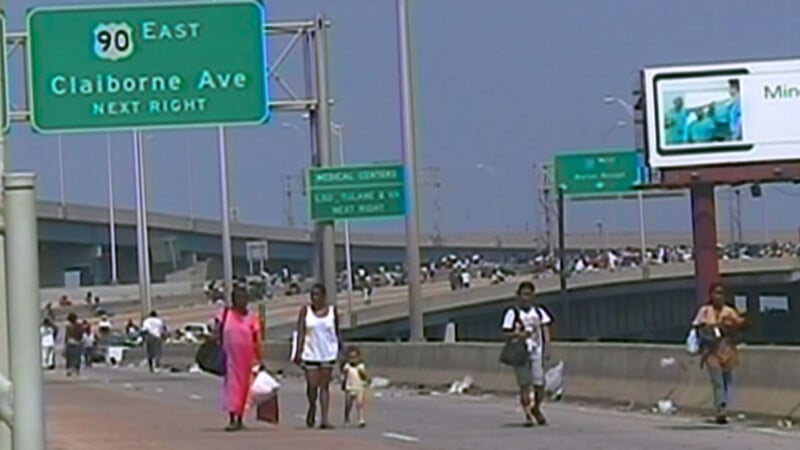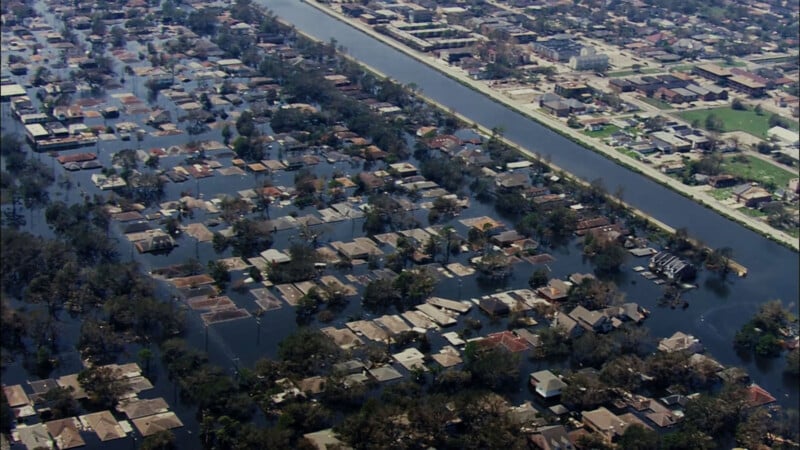Nat Geo’s ‘Hurricane Katrina’ Documentary Removes the Gap Between the Past and Present
![]()
This year marks the 20th anniversary of the devastating Hurricane Katrina, which killed nearly 2,000 people, primarily in Louisiana and Mississippi. National Geographic‘s new documentary series, Hurricane Katrina: Race Against Time, transports viewers back to the chaos and destruction Katrina wrought in New Orleans, and shines a much-needed light on the people and stories that were ignored back in 2005.
The first three of five episodes of Hurricane Katrina: Race Against Time premiere tonight, July 27th, on National Geographic and will arrive on Disney+ and Hulu tomorrow, while the final two episodes air tomorrow night and land on streaming on Tuesday, July 29th.
The series is directed by Oscar-nominated filmmaker Traci Curry and produced by the Oscar- and Emmy-winning team at Lightbox, as well as Ryan Coogler’s production company, Proximity Media. PetaPixel chatted with the series’ producer, Myles Estey, and lead editor, Jeremy Siefer, about Hurricane Katrina: Race Against Time‘s compelling blend of archival footage, eye-witness accounts, and modern filmmaking.
“It was shocking. It was a ‘how is this happening in this country?’ moment,” Siefer tells PetaPixel. ”

Estey adds, “It’s a big story that had huge news coverage at the time, probably a week or 10 days of basically 24-hour coverage.”
Although Katrina hit the southeastern United States 20 years ago, it can simultaneously feel like it was only yesterday. It was such a significant moment.
“It’s a big responsibility in the early stages of the project,” Estey says. “It’s hard not to feel overwhelmed by the enormity of the story in terms of its importance to so many people — the people of New Orleans, first and foremost.”
“But like Jeremy said, many people around the country at the time had some version of, ‘Wow, I cannot believe this is happening.’ And in the two years of making the [series], my friends, family, colleagues, people I ran into, had interesting reactions. Most people were like, ‘Wow, it’s already been 20 years.’ I think it’s a mix of it feeling like it could have been 100 years ago but also some of those memories are really etched in people’s brains.”

Estey explains that as he and the team spoke to the survivors of Katrina 20 years later, many of them were instantly transported back to the horrible event as soon as they started talking about it again. Tragedy has a way of feeling so distant and yet so close all at once.
“A lot of the coverage at the time was fairly salacious,” Estey recalls. “I think there was certainly news coverage that wasn’t painting people in the most favorable light. And I think at times we had to dig pretty deep — there were thousands and thousands of hours of archival footage between all the major news networks.”




Estey and Siefer also reviewed a significant amount of footage captured by people on the ground. While smartphone camera technology was nowhere near the level it is now in 2005, people could still capture photos and videos with dedicated cameras and camcorders, although power outages were a significant limiting factor.
But Hurricane Katrina: Race Against Time is not about retreading the same ground; it is about telling new stories that went largely ignored during the disaster, largely because of racial and socioeconomic divides. Much of the coverage back in 2005 exploited the tragedy and pointed fingers at the people who stayed behind in New Orleans, largely ignoring the diverse reasons why people tried to weather the storm.
“A lot of our work was trying to find different people who stayed for different reasons,” Estey says. “That was a big objective and goal of Traci Curry. No person can be a monolith for every person who stayed behind.”
Some people stayed to care for elderly family who could not possibly leave, others stayed to protect their home, some were essential workers who had a duty to stay put, and many more stayed behind because they had no means of leaving.
“There are a lot of reasons people stayed, and I think many counter this sort of idea that ‘Oh, people didn’t feel like leaving’ or didn’t care and didn’t think there was risk,” Estey says. “That wasn’t the case at all.”



He also notes that the messaging from the city and state was inconsistent and arrived too late for many to evacuate. ”If you don’t have the means to leave, what do you do? There are a lot of questions like this that don’t get answered by simple news coverage.”
Bringing the Past to the Present Through Archival Footage and New Filmmaking
“There are two main elements to a documentary about the past,” Siefer tells PetaPixel. “There’s archival footage and photographs, the artifacts themselves from the period. And then there are the people who have stories to tell [now]. The people who have stories to tell is the more important element for me.”
For Siefer, his editing task is immense. There is a huge sifting process, of course, but Siefer says that the editing of new interviews is even more critical.
“Everyone focuses on the quantity of the archival, but we’re talking about hundreds of hours of new interviews as well,” Siefer says. “These are people who haven’t told their story before. So the power of their memories, there’s a moment for them when the 20 years [disappear]. The gap between the past and present disappears and you can see it in the emotion of their storytelling.”

“So for me, sometimes it’s about getting out of the way and letting those stories and the emotion of those stories ring,” Siefer says. “That’s more valuable than any sort of unseen, never-before-seen footage [from 20 years ago]. It’s the never-before-heard stories that matter to me.”
‘The gap between the past and present disappears… ‘
Estey notes that some of these new stories were very difficult to hear, and some of the footage is so hard to watch.
“We had conversations about that as a team. For whatever personal reasons, certain footage touches someone more than other footage, and that can be everything from police violence to stories dealing firsthand the death of pets or people running out of food and water to young children left out in the Sun,” Estey says. “That stuff can be very hard to watch and, well, we watched a lot of that.”
However, the series is not just about the tragedy; it is also about how people persevered and survived.
“There are also really beautiful moments you see. Sometimes that’s the most impressive — when everything has gone wrong and people are still being not just decent humans, but excellent humans to each other. That is really rewarding.”
For Siefer, who is laser-focused on telling stories that haven’t been heard before, a big part of that task was sharing stories from New Orleans’ large black community, which was disproportionately harmed by Hurricane Katrina. While storms don’t see race, the impact of Katrina, like many natural disasters, was not felt equally by all communities, and how people think about the government’s response to the disaster varies wildly by race.
Some of these problems remain and have been observed in subsequent natural disasters, which are expected to increase in frequency and intensity due to climate change. Estey and Siefer hope that people in 2025 can take valuable lessons forward from 2005 and the people who survived Hurricane Katrina.
“We get the chance every day to make millions of choices, and people under duress often make kind, caring, and selfless decisions,” Estey says. “We saw people who made really impressive choices in a really bad situation, and that can be inspiring for day-to-day life.”



“And I think it’s also important to remember that where there’s so much destruction, disaster, and death in the [news] narrative, there is often more to it,” Estey adds.
“I think stories can really touch people emotionally and will hopefully get them to think beyond ‘Oh, this is a bad thing that happened to someone,'” Siefer says. “What if we could learn something from this experience and do something a little bit different? Even if that little different thing is to open our minds to the possibility that we, as a society, bear some responsibility in terms of the environment we live in. I hope one thing people can take away [from the series] is to open their minds to the possibility that what happened to the people of New Orleans 20 years ago could happen to them, could happen to their loved ones.”
Airing Now
Hurricane Katrina: Race Against Time premieres on National Geographic tonight in will arrive on streaming platforms tomorrow. Both Siefer and Estey emphasize that the series was a massive team effort, and it would have been impossible to work through all the old and new footage without a large, dedicated group.
Image credits: National Geographic